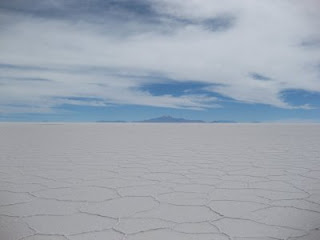
A sea of salt.
The highlight of my vacation was a trip to the Salar de Uyuni--the largest salt flat in the world. Situated in Southwest Bolivia at an altitude of nearly 12,000 feet, the Salt Flat covers an area of almost 7,500 square miles. It formed as the result of the drying up of Lake Minchín--a prehistoric salt lake that covered most all of southwest Bolivia. Today it's a popular tourist destination for international and national travelers.

Two workers use shovels to load up this camion with salt to haul away for processing.
The immensity of the Salt Flat is beyond my comprehension. And its ability to play tricks on the mind is boggling. When we stopped at the Isla de los Pescadores (Fishermen's Island) and looked out from the cacti-filled land mass, I felt like I was at sea--the whiteness of the salt like an ocean and the occasional land masses popping up in the distance like islands.


View from the Isla de los Pescadores where giant cactus, more than 1,000 years old, crowd the island.
Ever the sociologist, I was most curious about the people who live out in the Salar. We briefly visited one small village located a two-hour drive from the main town of Uyuni. I asked our driver/tour guide, Mario, about the types of services that existed for the people of the little village located at the base of a volcano. He explained that there is a grade school, but no basic health services. Transportation, he said, passes by once a week.

The Wiphala--the flag of the indigenous people of Bolivia--flies in the middle of the Salar de Uyuni.
"They are very leary of outsiders," Mario said. "They have very little experience with people outside of their villages because they live such remote lives. They do not trust foreigners." People in the area, Mario told me, work in the salt industry...or they are miners or famers (quinoa). From what I saw, it's a very difficult and cold life.
Things could change though. Last January and February major news outlets reported that Bolivia's vast salar is home to the world's largest lithium reserve--an essential element for making the batteries to power electric and hybrid cars. Meanwhile, as the whole world flirts with Bolivia to gain access to its lithium-filled reserve, the Salt Flat remains relatively untouched... except by tourists like me, who come curious and leave amazed.
No comments:
Post a Comment